warning light TESLA MODEL S 2012 Owner Safety Information
[x] Cancel search | Manufacturer: TESLA, Model Year: 2012, Model line: MODEL S, Model: TESLA MODEL S 2012Pages: 28, PDF Size: 2.9 MB
Page 3 of 28
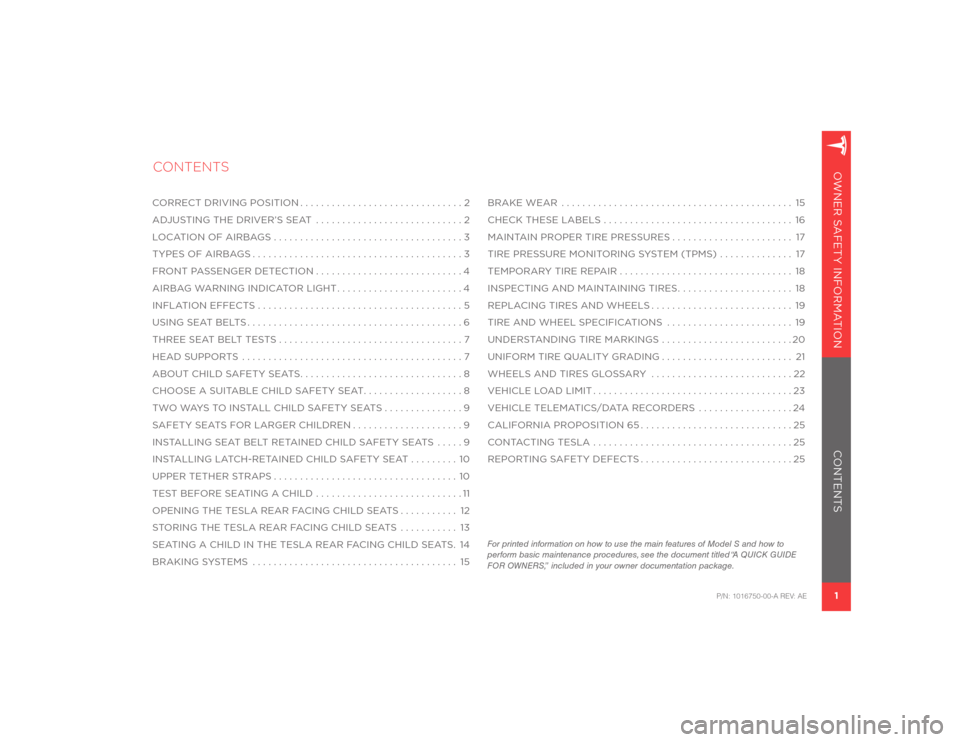
1OWNER SAFETY INFORMATIONCONTENTS
CONTENTS
BRAKE WEAR . . . . . . . . . . . . . . . . . . . . . . . . . . . . . . . . . . . . . . . . . . . . 15
CHECK THESE LABELS . . . . . . . . . . . . . . . . . . . . . . . . . . . . . . . . . . . . 16
MAINTAIN PROPER TIRE PRESSURES . . . . . . . . . . . . . . . . . . . . . . . 17
TIRE PRESSURE MONITORING SYSTEM (TPMS) . . . . . . . . . . . . . . 17
TEMPORARY TIRE REPAIR . . . . . . . . . . . . . . . . . . . . . . . . . . . . . . . . . 18
INSPECTING AND MAINTAINING TIRES . . . . . . . . . . . . . . . . . . . . . . 18
REPLACING TIRES AND WHEELS . . . . . . . . . . . . . . . . . . . . . . . . . . . 19
TIRE AND WHEEL SPECIFICATIONS . . . . . . . . . . . . . . . . . . . . . . . . 19
UNDERSTANDING TIRE MARKINGS . . . . . . . . . . . . . . . . . . . . . . . . . 20
UNIFORM TIRE QUALITY GRADING . . . . . . . . . . . . . . . . . . . . . . . . . 21
WHEELS AND TIRES GLOSSARY . . . . . . . . . . . . . . . . . . . . . . . . . . . 22
VEHICLE LOAD LIMIT . . . . . . . . . . . . . . . . . . . . . . . . . . . . . . . . . . . . . . 23
VEHICLE TELEMATICS/DATA RECORDERS . . . . . . . . . . . . . . . . . . 24
CALIFORNIA PROPOSITION 65 . . . . . . . . . . . . . . . . . . . . . . . . . . . . . 25
CONTACTING TESLA . . . . . . . . . . . . . . . . . . . . . . . . . . . . . . . . . . . . . . 25
REPORTING SAFETY DEFECTS . . . . . . . . . . . . . . . . . . . . . . . . . . . . . 25 CORRECT DRIVING POSITION . . . . . . . . . . . . . . . . . . . . . . . . . . . . . . . 2
ADJUSTING THE DRIVER’S SEAT . . . . . . . . . . . . . . . . . . . . . . . . . . . . 2
LOCATION OF AIRBAGS . . . . . . . . . . . . . . . . . . . . . . . . . . . . . . . . . . . . 3
TYPES OF AIRBAGS . . . . . . . . . . . . . . . . . . . . . . . . . . . . . . . . . . . . . . . . 3
FRONT PASSENGER DETECTION . . . . . . . . . . . . . . . . . . . . . . . . . . . . 4
AIRBAG WARNING INDICATOR LIGHT . . . . . . . . . . . . . . . . . . . . . . . . 4
INFLATION EFFECTS . . . . . . . . . . . . . . . . . . . . . . . . . . . . . . . . . . . . . . . 5
USING SEAT BELTS . . . . . . . . . . . . . . . . . . . . . . . . . . . . . . . . . . . . . . . . . 6
THREE SEAT BELT TESTS . . . . . . . . . . . . . . . . . . . . . . . . . . . . . . . . . . . 7
HEAD SUPPORTS . . . . . . . . . . . . . . . . . . . . . . . . . . . . . . . . . . . . . . . . . . 7
ABOUT CHILD SAFETY SEATS . . . . . . . . . . . . . . . . . . . . . . . . . . . . . . . 8
CHOOSE A SUITABLE CHILD SAFETY SEAT . . . . . . . . . . . . . . . . . . . 8
TWO WAYS TO INSTALL CHILD SAFETY SEATS . . . . . . . . . . . . . . . 9
SAFETY SEATS FOR LARGER CHILDREN . . . . . . . . . . . . . . . . . . . . . 9
INSTALLING SEAT BELT RETAINED CHILD SAFETY SEATS . . . . . 9
INSTALLING LATCH-RETAINED CHILD SAFETY SEAT . . . . . . . . . 10
UPPER TETHER STRAPS . . . . . . . . . . . . . . . . . . . . . . . . . . . . . . . . . . . 10
TEST BEFORE SEATING A CHILD . . . . . . . . . . . . . . . . . . . . . . . . . . . . 11
OPENING THE TESLA REAR FACING CHILD SEATS . . . . . . . . . . . 12
STORING THE TESLA REAR FACING CHILD SEATS . . . . . . . . . . . 13
SEATING A CHILD IN THE TESLA REAR FACING CHILD SEATS . 14
BRAKING SYSTEMS . . . . . . . . . . . . . . . . . . . . . . . . . . . . . . . . . . . . . . . 15
P/N: 1016750-00-A REV: AE
For printed information on how to use the main features of Model S and how to
perform basic maintenance procedures, see the document titled “A QUICK GUIDE
FOR OWNERS,” included in your owner documentation package.
Page 4 of 28
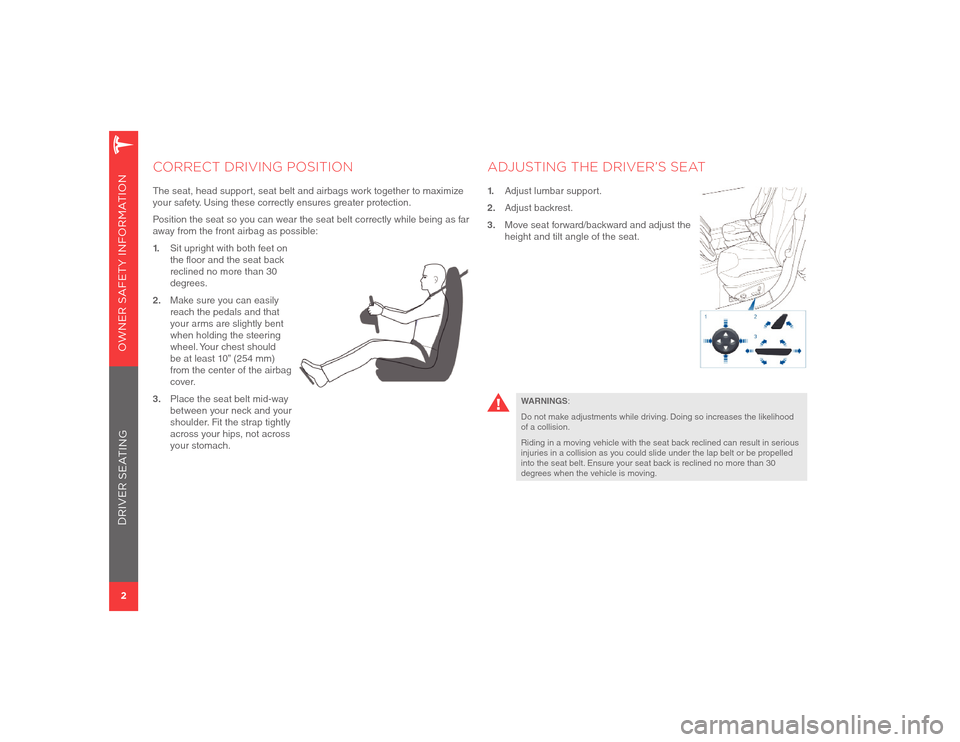
2OWNER SAFETY INFORMATIONDRIVER SEATING
CORRECT DRIVING POSITIONThe seat, head support, seat belt and airbags work together to maximize
your safety. Using these correctly ensures greater protection.
Position the seat so you can wear the seat belt correctly while being as far
away from the front airbag as possible:
1. Sit upright with both feet on
the floor and the seat back
reclined no more than 30
degrees.
2. Make sure you can easily
reach the pedals and that
your arms are slightly bent
when holding the steering
wheel. Your chest should
be at least 10” (254 mm)
from the center of the airbag
cover.
3. Place the seat belt mid-way
between your neck and your
shoulder. Fit the strap tightly
across your hips, not across
your stomach.
ADJUSTING THE DRIVER’S SEAT1. Adjust lumbar support.
2. Adjust backrest.
3. Move seat forward/backward and adjust the
height and tilt angle of the seat.
WARNINGS:
Do not make adjustments while driving. Doing so increases the likelihood
of a collision.
Riding in a moving vehicle with the seat back reclined can result in serious
injuries in a collision as you could slide under the lap belt or be propelled
into the seat belt. Ensure your seat back is reclined no more than 30
degrees when the vehicle is moving.
Page 6 of 28
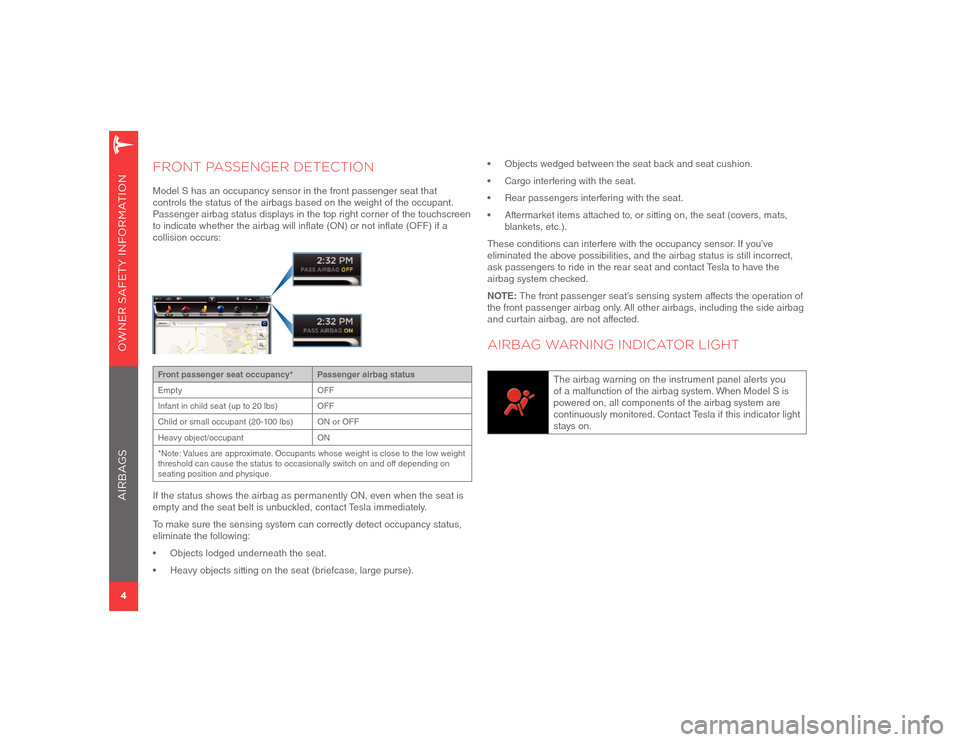
4OWNER SAFETY INFORMATIONAIRBAGS
FRONT PASSENGER DETECTIONModel S has an occupancy sensor in the front passenger seat that
controls the status of the airbags based on the weight of the occupant.
Passenger airbag status displays in the top right corner of the touchscreen
to indicate whether the airbag will inflate (ON) or not inflate (OFF) if a
collision occurs:Front passenger seat occupancy* Passenger airbag status
Empty OFF
Infant in child seat (up to 20 lbs) OFF
Child or small occupant (20-100 lbs) ON or OFF
Heavy object/occupant ON
*Note: Values are approximate. Occupants whose weight is close to the low weight
threshold can cause the status to occasionally switch on and off depending on
seating position and physique.If the status shows the airbag as permanently ON, even when the seat is
empty and the seat belt is unbuckled, contact Tesla immediately.
To make sure the sensing system can correctly detect occupancy status,
eliminate the following:
• Objects lodged underneath the seat.
• Heavy objects sitting on the seat (briefcase, large purse).• Objects wedged between the seat back and seat cushion.
• Cargo interfering with the seat.
• Rear passengers interfering with the seat.
• Aftermarket items attached to, or sitting on, the seat (covers, mats,
blankets, etc.).
These conditions can interfere with the occupancy sensor. If you’ve
eliminated the above possibilities, and the airbag status is still incorrect,
ask passengers to ride in the rear seat and contact Tesla to have the
airbag system checked.
NOTE: The front passenger seat’s sensing system affects the operation of
the front passenger airbag only. All other airbags, including the side airbag
and curtain airbag, are not affected.
AIRBAG WARNING INDICATOR LIGHT
The airbag warning on the instrument panel alerts you
of a malfunction of the airbag system. When Model S is
powered on, all components of the airbag system are
continuously monitored. Contact Tesla if this indicator light
stays on.
Page 7 of 28
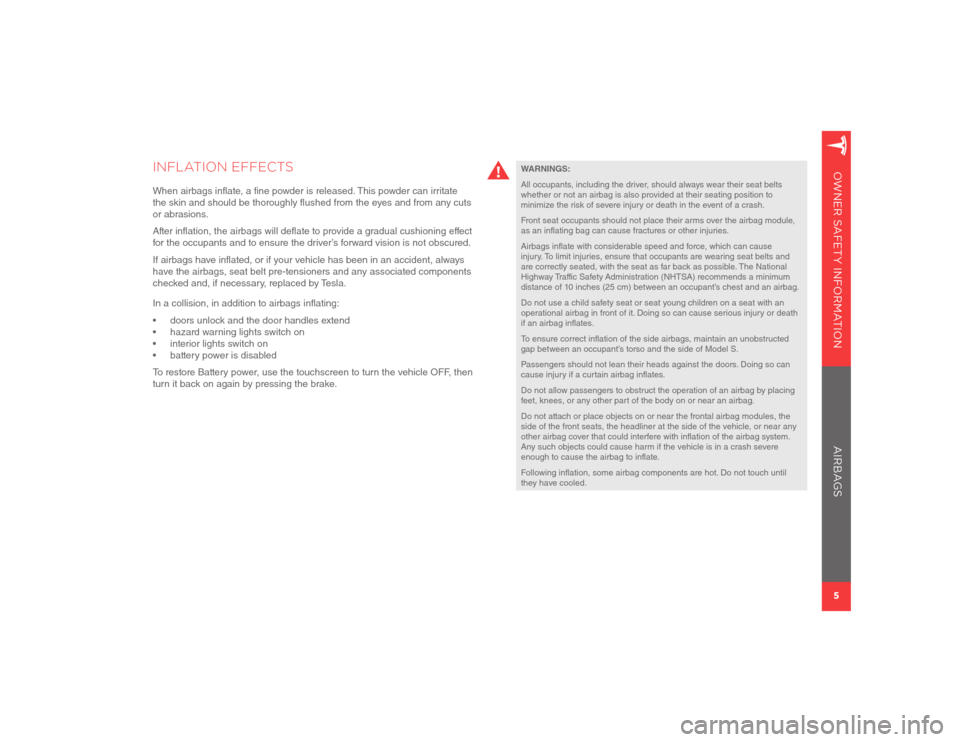
5OWNER SAFETY INFORMATION
INFLATION EFFECTSWhen airbags inflate, a fine powder is released. This powder can irritate
the skin and should be thoroughly flushed from the eyes and from any cuts
or abrasions.
After inflation, the airbags will deflate to provide a gradual cushioning effect
for the occupants and to ensure the driver’s forward vision is not obscured.
If airbags have inflated, or if your vehicle has been in an accident, always
have the airbags, seat belt pre-tensioners and any associated components
checked and, if necessary, replaced by Tesla.
In a collision, in addition to airbags inflating:
• doors unlock and the door handles extend
• hazard warning lights switch on
• interior lights switch on
• battery power is disabled
To restore Battery power, use the touchscreen to turn the vehicle OFF, then
turn it back on again by pressing the brake.
WARNINGS:
All occupants, including the driver, should always wear their seat belts
whether or not an airbag is also provided at their seating position to
minimize the risk of severe injury or death in the event of a crash.
Front seat occupants should not place their arms over the airbag module,
as an inflating bag can cause fractures or other injuries.
Airbags inflate with considerable speed and force, which can cause
injury. To limit injuries, ensure that occupants are wearing seat belts and
are correctly seated, with the seat as far back as possible. The National
Highway Traffic Safety Administration (NHTSA) recommends a minimum
distance of 10 inches (25 cm) between an occupant’s chest and an airbag.
Do not use a child safety seat or seat young children on a seat with an
operational airbag in front of it. Doing so can cause serious injury or death
if an airbag inflates.
To ensure correct inflation of the side airbags, maintain an unobstructed
gap between an occupant’s torso and the side of Model S.
Passengers should not lean their heads against the doors. Doing so can
cause injury if a curtain airbag inflates.
Do not allow passengers to obstruct the operation of an airbag by placing
feet, knees, or any other part of the body on or near an airbag.
Do not attach or place objects on or near the frontal airbag modules, the
side of the front seats, the headliner at the side of the vehicle, or near any
other airbag cover that could interfere with inflation of the airbag system.
Any such objects could cause harm if the vehicle is in a crash severe
enough to cause the airbag to inflate.
Following inflation, some airbag components are hot. Do not touch until
they have cooled.
AIRBAGS
Page 19 of 28
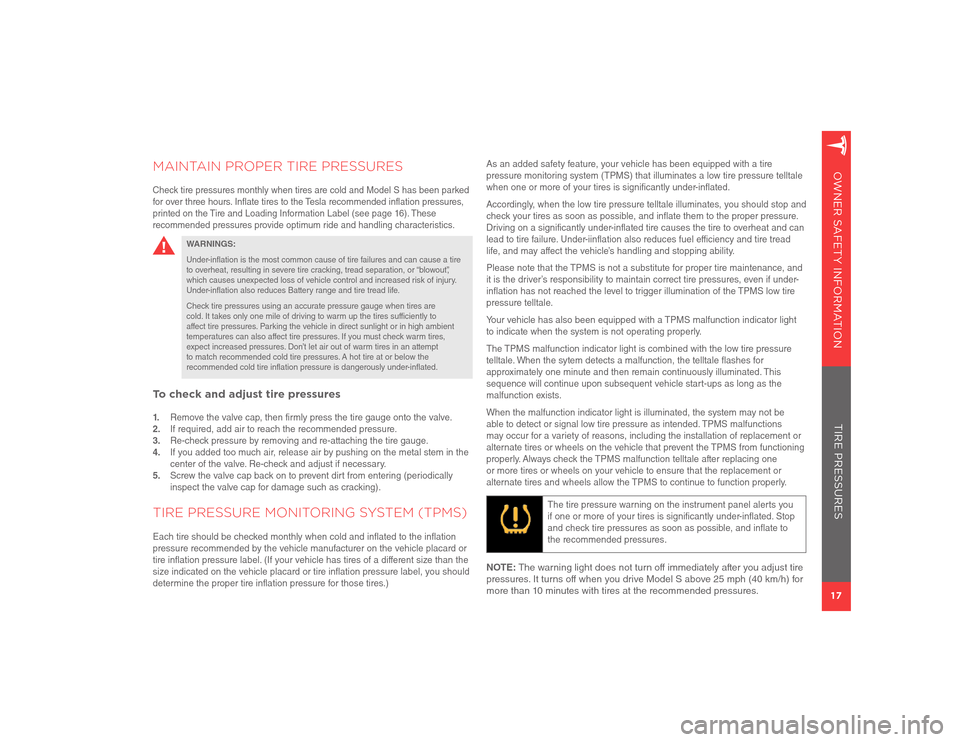
17OWNER SAFETY INFORMATION
MAINTAIN PROPER TIRE PRESSURESCheck tire pressures monthly when tires are cold and Model S has been parked
for over three hours. Inflate tires to the Tesla recommended inflation pressures,
printed on the Tire and Loading Information Label (see page 16). These
recommended pressures provide optimum ride and handling characteristics.
WARNINGS:Under-inflation is the most common cause of tire failures and can cause a tire
to overheat, resulting in severe tire cracking, tread separation, or “blowout”,
which causes unexpected loss of vehicle control and increased risk of injury.
Under-inflation also reduces Battery range and tire tread life.
Check tire pressures using an accurate pressure gauge when tires are
cold. It takes only one mile of driving to warm up the tires sufficiently to
affect tire pressures. Parking the vehicle in direct sunlight or in high ambient
temperatures can also affect tire pressures. If you must check warm tires,
expect increased pressures. Don’t let air out of warm tires in an attempt
to match recommended cold tire pressures. A hot tire at or below the
recommended cold tire inflation pressure is dangerously under-inflated.
To check and adjust tire pressures1. Remove the valve cap, then firmly press the tire gauge onto the valve.
2. If required, add air to reach the recommended pressure.
3. Re-check pressure by removing and re-attaching the tire gauge.
4. If you added too much air, release air by pushing on the metal stem in the
center of the valve. Re-check and adjust if necessary.
5. Screw the valve cap back on to prevent dirt from entering (periodically
inspect the valve cap for damage such as cracking).TIRE PRESSURE MONITORING SYSTEM (TPMS)Each tire should be checked monthly when cold and inflated to the inflation
pressure recommended by the vehicle manufacturer on the vehicle placard or
tire inflation pressure label. (If your vehicle has tires of a different size than the
size indicated on the vehicle placard or tire inflation pressure label, you should
determine the proper tire inflation pressure for those tires.)As an added safety feature, your vehicle has been equipped with a tire
pressure monitoring system (TPMS) that illuminates a low tire pressure telltale
when one or more of your tires is significantly under-inflated.
Accordingly, when the low tire pressure telltale illuminates, you should stop and
check your tires as soon as possible, and inflate them to the proper pressure.
Driving on a significantly under-inflated tire causes the tire to overheat and can
lead to tire failure. Under-iinflation also reduces fuel efficiency and tire tread
life, and may affect the vehicle’s handling and stopping ability.
Please note that the TPMS is not a substitute for proper tire maintenance, and
it is the driver’s responsibility to maintain correct tire pressures, even if under-
inflation has not reached the level to trigger illumination of the TPMS low tire
pressure telltale.
Your vehicle has also been equipped with a TPMS malfunction indicator light
to indicate when the system is not operating properly.
The TPMS malfunction indicator light is combined with the low tire pressure
telltale. When the sytem detects a malfunction, the telltale flashes for
approximately one minute and then remain continuously illuminated. This
sequence will continue upon subsequent vehicle start-ups as long as the
malfunction exists.
When the malfunction indicator light is illuminated, the system may not be
able to detect or signal low tire pressure as intended. TPMS malfunctions
may occur for a variety of reasons, including the installation of replacement or
alternate tires or wheels on the vehicle that prevent the TPMS from functioning
properly. Always check the TPMS malfunction telltale after replacing one
or more tires or wheels on your vehicle to ensure that the replacement or
alternate tires and wheels allow the TPMS to continue to function properly.
The tire pressure warning on the instrument panel alerts you
if one or more of your tires is significantly under-inflated. Stop
and check tire pressures as soon as possible, and inflate to
the recommended pressures
.
NOTE: The warning light does not turn off immediately after you adjust tire
pressures. It turns off when you drive Model S above 25 mph (40 km/h) for
more than 10 minutes with tires at the recommended pressures.
TIRE PRESSURES
Page 21 of 28
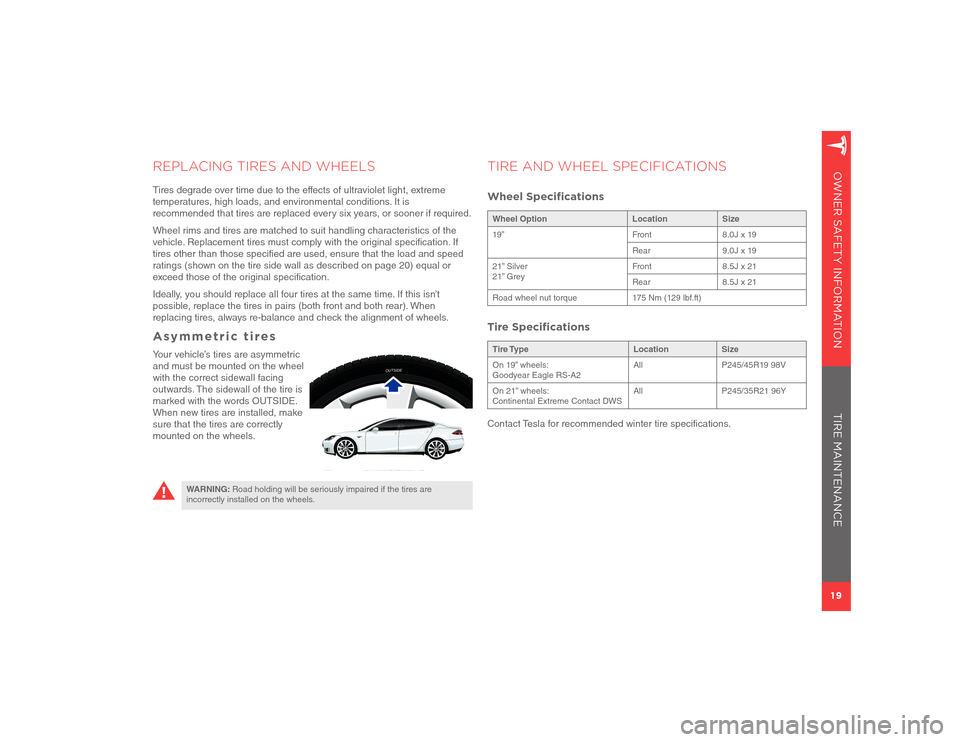
19OWNER SAFETY INFORMATION
TIRE AND WHEEL SPECIFICATIONSWheel Specifi cationsWheel Option Location Size
19” Front 8.0J x 19
Rear 9.0J x 19
21” Silver
21” GreyFront 8.5J x 21
Rear 8.5J x 21
Road wheel nut torque 175 Nm (129 lbf.ft)Tire Specifi cationsTire Type Location Size
On 19” wheels:
Goodyear Eagle RS-A2All P245/45R19 98V
On 21” wheels:
Continental Extreme Contact DWSAll P245/35R21 96YContact Tesla for recommended winter tire specifications.
REPLACING TIRES AND WHEELSTires degrade over time due to the effects of ultraviolet light, extreme
temperatures, high loads, and environmental conditions. It is
recommended that tires are replaced every six years, or sooner if required.
Wheel rims and tires are matched to suit handling characteristics of the
vehicle. Replacement tires must comply with the original specification. If
tires other than those specified are used, ensure that the load and speed
ratings (shown on the tire side wall as described on page 20) equal or
exceed those of the original specification.
Ideally, you should replace all four tires at the same time. If this isn’t
possible, replace the tires in pairs (both front and both rear). When
replacing tires, always re-balance and check the alignment of wheels.Asymmetric tiresYour vehicle’s tires are asymmetric
and must be mounted on the wheel
with the correct sidewall facing
outwards. The sidewall of the tire is
marked with the words OUTSIDE.
When new tires are installed, make
sure that the tires are correctly
mounted on the wheels.
WARNING: Road holding will be seriously impaired if the tires are
incorrectly installed on the wheels.
OUTSIDE
TIRE MAINTENANCE